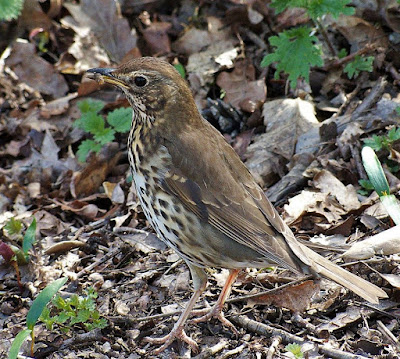 |
| Curlew in seaweed - Photo by Mark Appleton |
The Curlew song and flight call can be heard by clicking on this link:-
Curlew Song
Curlew Call
When I show people the Curlew through my spotting scope the general reaction is "WOW". Its not only their bill but their beautiful plumage when seen close up that dazzles. Not everyone can get to a green space, but now some of the lock down restrictions have been relaxed and people are able to drive to locations to exercise, it is important we are aware of our ground nesting birds and the impact we can have on them. Think twice we before you trample off into the undergrowth or let your dog off the lead in what maybe a very sensitive area, especially in forest and heathland.
 |
| Curlew looking for food - Photo by Mark Appleton |
Unfortunately the breeding population of the Curlew is on a downward curve and they are now endangered and placed on the red list. The RSPB recognizes the Curlew as one of the highest priority conservation species in the UK.
I worked as a Bird Aware Solent ranger last winter. See more here:- Bird Aware Solent. I often saw Curlew feeding at low tide looking for marine worms and crustaceans in the sand. I was involved with engaging with the public to help them enjoy the coast but at the same time making people aware of the effects of disturbance to the overwintering birds. Disturbance could be due to walkers, dog walkers, watersport users, joggers etc etc. If a bird flies, once disturbed, it will use valuable energy flying off and a days worth of feeding can soon be easily wasted. They may not return to the valuable feeding area. One reason I took the job as a ranger was to try and help with the conservation of wildlife for future generations to enjoy.
The Curlew is our largest breeding wader with a very long deeply downcurved bill and long legs. Its head is rather plain lacking the bold stripes on the crown of the similar looking but smaller Whimbrel. The female has a longer bill than the male.
 |
| Curlew - Photo by Mark Appleton |
So why am I talking about the Curlew now, especially when you are most likely to spot one on the shoreline in winter. Well because their breeding season is now (April/May) and they are very vulnerable as a ground nesting bird to human disturbance and natural predators. They are still moderately common coastal birds but they have declined greatly on their (generally) moorland nesting grounds. Figures released by conservation group Wild New Forest (WNF) show a decline of two thirds in breeding pairs in the New Forest national park in the last 10 years. Disturbance is likely to be one of the major causes of the decline. It’s vital that we do all we can to reduce instances of these birds being startled by people and the nests and young being abandoned.
 |
| Curlew flying - Photo by Mark Appleton |
Conservationists say that people out and about in the New Forest can take simple steps to help save these rare birds. Anyone can play a vital part in protecting curlews by minimising disturbance on their breeding grounds in spring and summer. Curlews and other New Forest breeding waders typically nest in open areas of heath and bog, so it is here that special care is needed by sticking to the main paths and keeping dogs on the lead to avoid adults being disturbed and abandoning their chicks.
 |
| Curlew - Photo by Mark Appleton |
Did You Know:-
- Curlews are migratory, but are present all year in the milder climate of the British Isles and the adjacent European coasts.
- Within its range the Curlew is most similar to the Whimbrel, but the latter is smaller and has a shorter bill that is less smoothly curved.
- They eat mostly worms, crabs and invertebrates, which they find by touch using their long curved bill to probe soft mud.
- Curlews are long lived birds and adults can reach 30 years of age.
- The end of a Curlew’s bill is sensitive and acts independently, acting like tweezers which enables it to feel around in the mud for prey.
 |
| Curlew -Photo by Mark Appleton |
The good news is that plenty of work has been done with signage to raise awareness in the New Forest. These signs make it clear that walkers and their dogs, runners, cyclists and horse riders should all stay on the main tracks when crossing heathland from now until August.
So remember our wildlife when going for a walk. It is the nesting time of year for our fabulous ground nesting Curlew, as well as others such as Meadow Pipet, Nightjar, Dartford Warbler. Lapwing and Skylarks to name a few.
For more information on the Curlew click on the following links:-
RSPB - The Curlew
The Wildlife Trusts - The Curlew
BTO - The Curlew
and lastly
A BIG SHOUT OUT FOR ALL OUR ESSENTIAL KEY WORKERS WHO ARE DOING AN AMAZING JOB IN THESE DIFFICULT TIMES
















